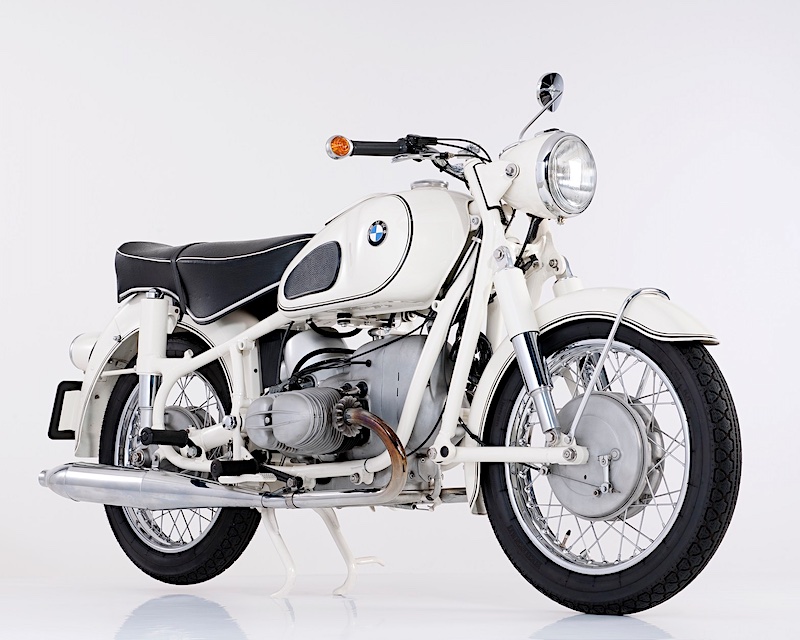Motorcycle Investor mag
Subscribe to our free email news
Falloon on BMW R69S
(by Ian Falloon, Feb 2022)

BMW's conservative R69S was a true mile-eater
Although BMW has
produced a variety of single, twin, four and six
cylinder motorcycles, it is
the boxer twin that has become the BMW trademark. Ever
since the first R32 of
1923, the most prized BMWs have been flat twins, and one
of the most sought-after
is the 600cc R69S.
Produced between 1960
and 1969 the R69S owed its origins to the 500cc R51/3 of
1951. While the R51/3
engine layout was similar to that of the earlier pre-war
overhead valve twins
there were many improvements. These included a single
camshaft driven by
helical cut gears instead of the earlier twin camshaft
design with its long
wear-prone timing chain.
Other developments saw
the magneto and generator now housed inside redesigned
engine covers but still
retained was the pressed-up crankshaft running on roller
bearings. However,
while the engine featured many improvements the general
chassis was carried
over from the pre-war models. This included a
rudimentary telescopic front fork
and dubious plunger rear end.
Considering BMW rose
from the ashes at the end of World War II, they were
going from strength to
strength in the early 1950s. For 1952 a 72x73mm 594cc
R67 and a higher
performance 35 horsepower R68 joined the R51/3. By late
1953 the 100,000th
post-war motorcycle left the rebuilt Munich works.
In 1955 the twins
finally received a new chassis, this following the
unusual form of the RS54
racer released a year earlier. The running gear now
included swingarm
suspension front and rear, with the driveshaft
incorporated within the rear
fork leg. While swingarm rear suspension was now
considered mainstream an
unusual leading-link Earles fork replaced the usual
telescopic front fork.
While providing built-in anti-dive under hard braking,
the Earles fork was
really more suitable for sidecar use, a popular
alternative in the 1950s.
These new twins became
the 500cc R50 and 600cc R69 but they also coincided with
a general downturn in
motorcycle sales that saw many Italian and German makes
disappear altogether.
BMW also narrowly avoided bankruptcy until the success
of the BMW 700 car
during 1959. Despite the gloomy times updated
twin-cylinder motorcycles were
released during 1960, one of these being the sporting
R69S.
Ostensibly identical
to the touring R69, underneath the R69S’s similar
exterior was a reworked
engine. With a 9.5:1 compression ratio and twin 26mm
Bing carburettors the
power was 42 horsepower at 7000 rpm. A timed rotary disc
engine breather was
mounted on the front of the camshaft and a larger air
filter and mufflers
improved gas flow.
Completing the
performance specification was a closer ratio four-speed
gearbox and a
hydraulic, rather than friction, steering damper.
The chassis was
carried over from the R69, with 18-inch alloy rimmed
wheels front and rear and
a 200mm twin-leading shoe front brake.
Although the R69S
weighed a considerable 202kg there were few machines
available at that time
that could comfortably and reliably cruise at high speed
on the German
Autobahns. An R69S wasn’t as agile as a comparable
British twin, and there were
some initial problems if the engine was revved unduly
hard. However, after BMW
incorporated a vibration damper on the end of the
crankshaft from 1963 the R69S
would run all day at its maximum speed of around 175
km/h. This was something
you couldn’t say about the British competition.
Unfortunately the
R69S’s conservatism counted against it during the 1960s.
Only available in
black with white pin striping (or white or red to
special order) they were
always expensive and exclusive. Against the good looks
and raw power of the
British vertical twin the BMW was seen as an
anachronism. Instead of a tiny
fuel tank and slim seat the R69S offered a 17 or
24-litre tank, small solo
saddle or large dual seat.
The only attempt at
modernisation was the alternative of new long-travel
telescopic forks for the US
market in 1967. However, these were not popular and
eschewed by the traditional
BMW buyer in favour of the traditional Earles fork
version. By 1969 the market
required a new machine, and economics dictated that the
R69S engine, with its
built-up crankshaft and gear-driven camshaft, be
replaced by one more suitable
for mass production.
With over 11,000
produced between 1960 and 1969 the R69S may not be a
limited production
machine, but it is still representative of that earlier
era when the
accountants didn’t rule the engineers.
As a motorcycle
possessing all those usual BMW qualities of comfort and
longevity, the R69S
provided the best of both worlds. An eminently practical
and useable classic
motorcycle, the R69S has justifiably earned a place as
one of the most
desirable post-war BMW motorcycles.

-------------------------------------------------
Produced by AllMoto abn 61 400 694 722
Privacy: we do not collect cookies or any other data.

Archives
Contact





